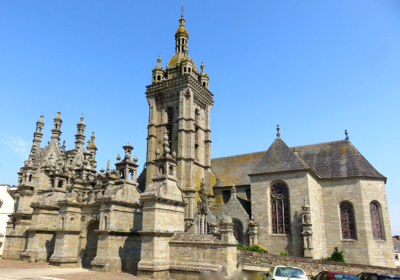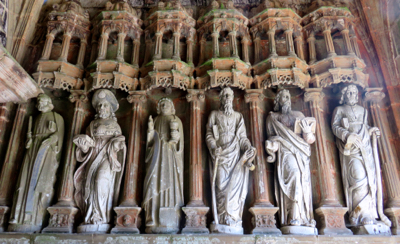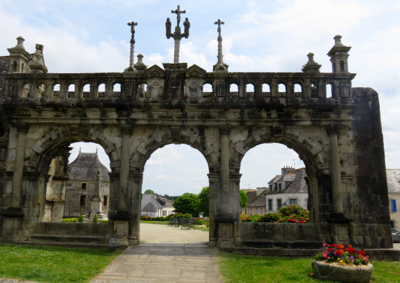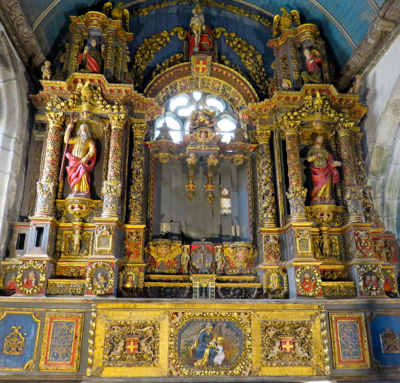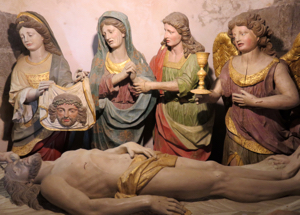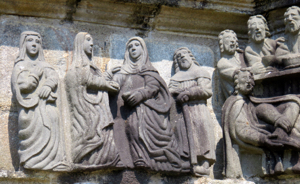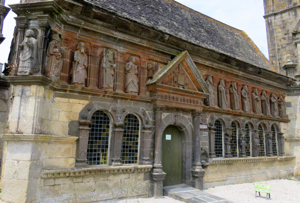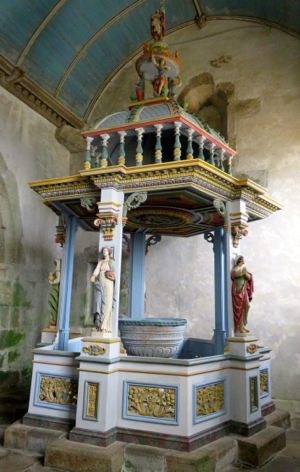 |
Enclos Paroissiaux, Brittany, France | |
| Small Breton towns with elaborate, sumptuous church complexes—how? Why? Visit a few to discover how 16th-century Brittany grew rich on the linen trade. | ||
|
|
|
Elaborate 16th and 17th-century church complexes were built in Breton towns made rich by the linen trade, with neighboring towns competing to make theirs the most sumptuous. Flax and linen were in great demand at this time, and Brittany grew the flax, prepared the cloth, and shipped it around the world, bringing great prosperity to the area. This part of France was also staunchly Catholic, and the combination of religious fervor and great wealth led to the creation of many enclos paroissiaux (parish closes), mostly in this part of Brittany. During this time of prosperity, parishes invested their revenues to embellish the parish closes.
Today these architectural marvels still exist, though they seem out of scale with the small, neat towns that surround them. Most are open daily, from 9:00 AM to 6:00 PM, but you might want to check locally. Note that there is an "Interpretation Center" in Guimiliau, which has exhibits about the enclos, maps showing where they are located, and other helpful information. The typical enclos paroissial is surrounded by a wall, which actually and symbolically separates the sacred space from the profane. Most are entered via a monuental gateway, which is still used for marriages and other ceremonies; the enclos have a medium-sized church with multiple altarpieces and rich, often sumptuous decoration; a calvaire (elevated statue of the Crucifixion, with varying levels of detail and complexity); a porch and sacristy adjoining the church;and an ossuaire (ossuary, or skeletal bone repository). Many originally included cemeteries, some of which still exist, but many have been moved to other locations. Here are a few of the best examples visitable using Morlaix as a base: Saint-ThégonnecSaint-Thégonnec, 13 km (8 miles) southwest of Morlaix (map), is a small, pretty town with a few hotels and restaurants, and one of the most impressive enclos paroissiaux in Brittany. As you approach the town, the soaring tower stands far above anything else. You enter through an ornate gate, topped with several lantern towers. Immediately you'll see the calvaire, the elevated scene portraying Christ's life and death, with a crucifix at the top. As you walk around the calvaire, you'll recognize scenes of the trial and sentencing of Jesus, leading to the crucifixion. In the competition among towns to create their enclos paroissiaux, the number of figures on the calvaire was important. St Thégonnec's calvaire dates from 1610.
The ossuary (1676 - 1681) no longer contains bones, but it does house a small gift shop. Of greater interest is the opportunity to go down a few steps to the sepulchre, where the "mise au tombeau" shows Jesus's body being prepared for burial. Created from 1699 to1702, these polychrome oak sculptures show a variety of expressions of the mourners. Plan to spend some time inside the church, where you will find several huge alterpieces, the most famous of which is the Rosary Alterpiece, created in the late 1600s/early 1700s. This massive wall shows Virgin Mary giving the rosary to St. Dominic and Ste. Catherine of Sienna; angels and children; Saint Louis; purgatory, with Christ receiving the souls that have been rescued; and God at the top. Other alterpieces and sculptures show John the Baptist and other saints. The ornate pulpit boasts golden angels and detailed carvings. When you emerge after taking in all the ornate interior decor, you're struck by the simple exterior facade of the church itself, in contrast to the ornate interior. If you only have time to visit one enclos, St-Thégonnec is a good choice and a fine example of the wealth of the 16th and 17th century inhabitants of this area. St-Thégonnec is described as "the final flourish." The richest parish in Léon in the late 17th century, it invested heavily in the close, with its two towers GuimiliauGuimiliau, 8 km (5 miles) southwest of Saint-Thégonnec (20 km/12.5 miles southwest of Morlaix, map), was keen to complete with its neighbor Saint-Thégonnec in ostentation: its enclos may be smaller, but its calvaire includes over two hundred figures. The gate is rather modest, but once inside you are immediately drawn to the calvaire. Huge and ornate, it dominates the church yard. Constructed between 1581 and 1588, this masterpiece includes 15 scenes from the life of Jesus and 17 scenes of the Passion, including the Last Supper. The Passion depicts people in costumes of the 16th century.
As you enter the church you are greeted by the apostles, six on each side of the entrance. Inside, the ornate octagonal baptistry (1675) with its carvings of animals and fruits, and the imposing carved organ loft greet you. Look up at the baptistry—it barely fits under the ceiling! Once again, you'll want to take the time to study the altarpieces. These include the Rosary altarpiece, the St. Joseph, and the St. Miliau. The Rosary altarpiece is from the 17th century. In addition to showing the delivery of the rosary to St-Dominic and Ste-Catherine of Siena, its ornate columns are decorated with angels. The Saint Joseph altarpiece is centered on Joseph holding the hand of the child Jesus; in addition it includes Sainte-Anne and Sainte-Elizabeth. Perhaps the strangest figure is Saint-Lawrence with his grill—apparently he was burned to death on a grill (and according to the myth, at one point suggested he was done enough and they should turn him over!) And then there is the Saint Miliau alterpiece, which includes pictures of the martyred saint carrying his own severed head. There is lots to see and absorb at Guimiliau! SizunSizun's claim to prominence is its three-arch monumental gate backed by a fine church with no fewer than five altars, each one with richer decoration than the last. The gate was built between 1585 and 1590 and is topped by the three crosses of a Calvary. In the churchyard there is also a pieta, believed to be left from a large Calvary that originally was on the site.
The church is dedicated to Saint-Suliau and was constructed in the 16th and 17th centuries. You may not have heard of St-Suliau, which may be because Brittany has some 26,000 saints! The five altars are ornate and portray Jesus, Mary, and Joseph, as well as the four evangelists, Saints Peter and Paul, and of course Saint-Suliau. In addition to several statues of the saint, there is also a solid silver bust of him, a relic. The 18th century pulpit includes beautiful gold work, and the baptistry is equally lovely. Around the ceiling are carved and painted sabliéres, beams that run below the ceiling. There's lots to look at inside! Perhaps of equal interest to the church is the ornate ossuary, with its beautiful and interesting carvings. Across the top march the 12 apostles, following Saint-Suliau who leads them. In addition, on one corner is what appears to be a mermaid, a carving with the bust and top half of a woman, and the bottom a serpent. At the lower level are other carvings, including sheathed caryatids and women who appear to be wearing only the scrolls they are carrying. Various other animals adorn the other corners of the ossuary, so be sure to take the time to walk around and look at it. Inside it now houses a small museum of Breton culture. Sizun is about 36 kilometers/22 miles southwest of Morlaix, a little farther than the previous two (map). CommanaCommana is a sleepy little town, which makes its enclos all the more surprising. It's just 27 kilometers (about 17 miles) from Morlaix, and only 10 kilometers/6 miles from Sizun, if you want to combine a visit. It is somewhat smaller than the others and perhaps less impressive at first glance. But it is known for its many beautiful altarpieces, particularly the Saint Anne Alterpiece and the Rosary Altarpiece. The huge Saint Anne alterpiece shows the Virgin Mary and Jesus in the middle, surrounded by statues of Saint Joachim and Saint Joseph. At the top there is an unusual depiction of God holding the resurrected Jesus. The Rosary Altarpiece shows Virgin Mary giving the rosary to Saint Dominic and Sainte Catherine of Sienna—by now a common scene if you've visited other enclos.
The Baptistry is unusual, with a granite font from 1656 and a carved wooden baldachin (canopy) that depicts Charity, Hope, Faith, Justice, and Temperance. The church was built between 1677 and 1687 and is named for Saint Derrien. Although you will see lots of churches while traveling in France, these Breton enclos paroissiaux are different than any others, and well worth visiting. Clustered in a relatively small area of Finistère, and all built in the 16th and 17th centuries, they provide a fascinating glimpse into the life and times of the flax producers of that era, and the amazing wealth they were able to accumulate. Choosing to invest this wealth in the churches has provided us with a fascinating glimpse into the history of this area
|
|
Above, Sepulchre in the ossuary at St-Thégonnec, showing Virgin Mary and Veronica, with Jesus's shroud. Carved from oak 1699 - 1702 by Jacques Laispagnol, who was paid 1550 livres in 1702.
|
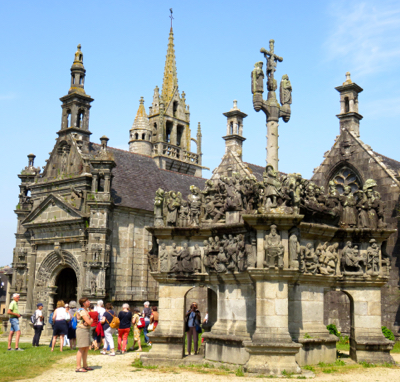 Visitors admire the 200 carved figures on the calvaire at Guimiliau.
Visitors admire the 200 carved figures on the calvaire at Guimiliau. 